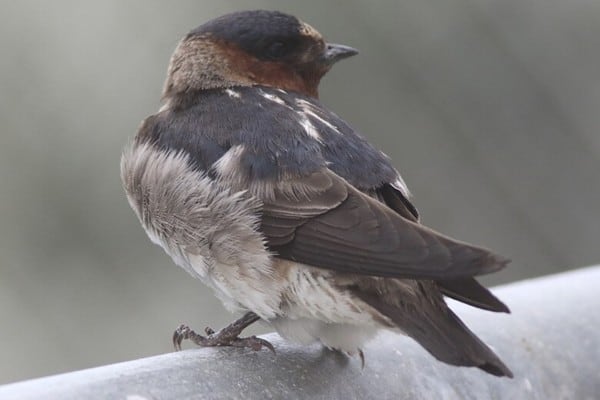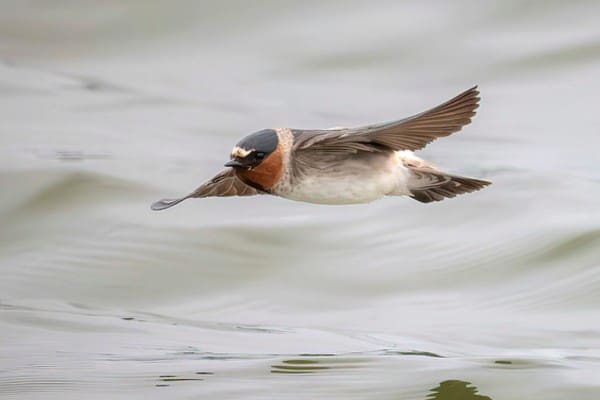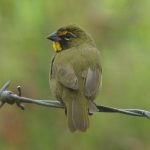Common Name: Cliff Swallow
Scientific Name: (Petrochelidon pyrrhonota)| Size | Diet | Range in Hawaii | Status in Hawaii |
|---|---|---|---|
| 5 in. - 6 in. | flies, mosquitoes, beetles, wasps, bees, and other flying insects | Unknown | Least Concern |
The Cliff Swallow (Petrochelidon pyrrhonota), also known as the American Swallow, is a fascinating and unique bird species that is native to North and South America. With its distinctive blue-black plumage and mud nests, this swallow is a beloved sight in its natural habitat.
However, the species is also known to make appearances as a non-breeding visitor and vagrant in Hawaii, where it is a rare and exciting sighting for birdwatchers. In this article, we’ll explore the fascinating world of the Cliff Swallow, its unique adaptations, and behavior in the wild.
Cliff Swallow
Appearance

The Cliff Swallow is a small bird with a distinctive appearance. It measures approximately 13-15 centimeters (5-6 inches) in length and has a wingspan of about 28-34 centimeters (11-13 inches).
The bird has a compact and streamlined body shape, with a short, square tail. Its wings are pointed, allowing for agile flight and maneuverability. The plumage of the Cliff Swallow varies depending on the individual’s age and sex.
Adult Cliff Swallows have a combination of colors on their upperparts, including glossy blue-black feathers on their head, back, and wings. They have a cinnamon-colored rump and a light-colored throat. Their underparts are pale with a slightly buffy hue.
Juvenile Cliff Swallows have a more subdued appearance, with brownish upperparts and pale underparts. Their feathers may show some streaking or mottling.
In flight, the Cliff Swallow displays a graceful and swift movement. Its wings appear long and pointed, and its tail shows a squared-off shape.
Diet
The diet of the Cliff Swallow primarily consists of small flying insects. As an insectivorous species, it feeds on a variety of airborne prey, including flies, mosquitoes, beetles, wasps, bees, and other flying insects. It catches its prey while in flight, displaying impressive aerial agility and maneuverability.
Nesting
Cliff Swallows are known for their unique nesting behavior. They construct intricate gourd-shaped nests made of mud pellets, which they attach to vertical surfaces such as cliffs, bridges, buildings, or even man-made structures like highway overpasses.
The nesting process begins with the collection of mud pellets, which the birds gather from nearby sources like mud puddles or moist soil. They mix the mud with their saliva to create a sticky substance that allows them to build and shape their nests.
Cliff Swallows meticulously build their nests, layering mud pellets and forming a cup-like structure with an entrance tunnel on the upper side. They often incorporate feathers, grass, and other plant materials to reinforce and line the nest’s interior.
The nests are typically attached to the chosen vertical surface, providing stability and protection against predators. The birds often nest in colonies, with many nests clustered together, offering additional safety and social interaction within the colony.
Cliff Swallows display strong site fidelity, returning to the same nesting locations year after year. They may even repair and reuse their existing nests, adding new layers of mud or making minor modifications.
During the breeding season, females lay a clutch of 3-6 eggs inside the nest. Both male and female birds participate in incubating the eggs, taking turns to keep them warm until they hatch, which typically takes around 14-16 days.
Once the eggs hatch, the parents work together to feed and care for the nestlings. They bring back a constant supply of insects to the nest, regurgitating the food to provide nutrition to their hungry chicks.
The nestling period lasts for about 20-25 days, during which time the young birds grow and develop their flight feathers. Once they are fully fledged, the young Cliff Swallows leave the nest, but they may still rely on their parents for food and guidance for a short period.
Behavior

The behavior of the Cliff Swallow encompasses a range of fascinating traits and adaptations. These birds exhibit colonial nesting behavior, with large colonies consisting of hundreds or even thousands of pairs.
They construct intricate gourd-shaped mud nests attached to vertical surfaces, displaying remarkable nest-building skills. When faced with predators, Cliff Swallows engage in cooperative defense, mobbing and harassing the threats to protect their nests and young.
Cliff Swallows are agile aerial foragers, capturing insects on the wing with impressive flight maneuvers. They often fly low to the ground or over bodies of water to take advantage of abundant insect populations. These birds undertake long-distance migrations, forming large flocks during their journeys between breeding grounds in North America and wintering grounds in South America.
Site fidelity is a notable behavior in Cliff Swallows, as they return to the same nesting sites year after year, showcasing their navigational abilities. Vocalizations play a vital role in communication, with Cliff Swallows using a range of calls, chirps, and trills to maintain contact within colonies and during interactions. Social interactions are observed within nesting colonies, including behaviors like preening, mutual grooming, and territorial displays.
Cliff Swallows have demonstrated adaptability to human-altered environments by utilizing man-made structures for nesting, such as bridges and buildings. This adaptability has allowed them to expand their range and successfully establish populations in diverse habitats. The behavior of the Cliff Swallow showcases their cooperative nature, aerial foraging prowess, migratory patterns, site fidelity, vocal communication, and ability to adapt to changing environments.
Habitat
The Cliff Swallow is a species that can adapt to a variety of habitats, but it is primarily associated with open areas near water sources. They are commonly found near cliffs, rocky outcrops, riverbanks, and lakeshores, where they can construct their mud nests on vertical surfaces.
Their preference for nesting on man-made structures, such as bridges, buildings, and highway overpasses, has allowed them to expand their habitat into urban and suburban areas. These structures provide suitable nesting sites that resemble their natural cliffside habitats.
Cliff Swallows are often found in habitats with abundant flying insect populations, as these insects serve as their main food source. They are frequently seen in open fields, meadows, agricultural areas, and near bodies of water where flying insects are plentiful.
During migration and wintering periods, Cliff Swallows inhabit a different range of habitats in South America. They may occupy grasslands, wetlands, savannas, and open woodland areas.
Range
The Cliff Swallow is not a native species to the Hawaiian Islands. While it breeds across North America and migrates to South America for the winter, its range does not include the Hawaiian Islands. There is only one recorded instance of the species in the Northwestern Hawaiian Islands, where two birds arrived at Tern Island in 1991.
However, this occurrence is considered a vagrant event and does not represent a regular presence or established population of Cliff Swallows in Hawaii
Conservation Status

The Cliff Swallow is currently assessed as a species of least concern by the International Union for Conservation of Nature (IUCN). This means that it is not facing significant threats or experiencing a rapid population decline.
The population of Cliff Swallows is considered stable and widespread throughout their breeding range in North America. They have adapted well to human-altered landscapes and are commonly found nesting on man-made structures such as bridges, buildings, and highway overpasses.
Interesting Facts
1. Nest reuse
Cliff Swallows typically return to the same nesting sites year after year, often adding new layers of mud to their existing nests. Some nests can become quite large over time.
2. Cooperative nest defense
When threatened by predators, Cliff Swallows engage in cooperative defense. They will mob and harass potential threats, such as snakes or birds of prey, in order to protect their nests and young.
3. Vocalizations
Cliff Swallows communicate through a variety of vocalizations, including chirps, chatters, and trills. These calls help them maintain contact within their colonies and during migration.
4. Long-distance migrators
Cliff Swallows undertake long-distance migrations, traveling from their breeding grounds in North America to their wintering grounds in South America. They can cover distances of thousands of miles during their annual journeys.
Frequently Asked Questions
1. Are Cliff Swallows social birds?
Yes, Cliff Swallows are highly social birds and often nest in large colonies, sometimes consisting of hundreds or thousands of pairs. This social behavior offers protection against predators.
2. How long do Cliff Swallows live?
While individual lifespans can vary, Cliff Swallows generally live for up to 8 years or more.
3. Can Cliff Swallows tolerate colder climates?
Cliff Swallows breed as far north as Alaska and northern Canada, indicating their ability to tolerate colder climates.
4. Are Cliff Swallows noisy birds?
While Cliff Swallows can be vocal, their vocalizations are not considered excessively noisy. They communicate with various calls, including chirps and trills, but their vocalizations are generally not disruptive or bothersome.




